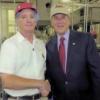Charles,
Your answer brought up a question for me.
We manufacture dry powders and have to annually buy timers, temperature/humidity detectors, and thermometers as the requirement for having all measure devices calibrated annually. This is cheaper than having them calibrated. Since none of these devices are linked to a CCP or even a PCP, are we required to have them calibrated?
The timer is used for 15 min timing of v-blender, the thermometer for the temperature of three compartment sink, even though we use a last step chlorine sanitizer (not needed to be hot) and have test strips.
Thanks!
Hi allen,
Some answers from Google -
--------------------------------------------------------------
Purpose of instrument calibration.
Calibration refers to the act of evaluating and adjusting the precision and accuracy of measurement equipment. Instrument calibration is intended to eliminate or reduce bias in an instrument's readings over a range for all continuous values.
---------------------------------------------------
Why calibration of instruments is important.
The main reasons for calibration are –
- To ensure the reliability of the instrument, that it can be trusted.
- To determine the accuracy of the instrument and
- To ensure the readings are consistent with other measurements
------------------------------------------------------------------
Calibration may be mandatory due to legal or FS/Q Standard Requirements eg –
Organisations certified to ISO 9001 are required to calibrate all their measuring equipment used to verify or control quality, and all such calibrations are required to be traceable to national or international standards (ISO 9001 1994 section 4.11, ISO 9001 2000 section 7.6).
-------------------------------------------------------------------------
The topic also relates to the use of master reference instruments and sub-master units.
















